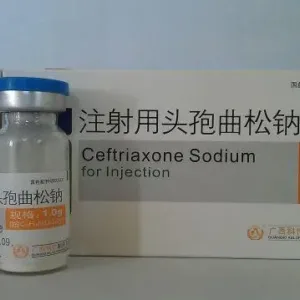Ceftriaxone Sodium for Injection .
Effects and efficacy: Ceftriaxone has antibacterial effects and is mainly used for infectious diseases caused by sensitive pathogens: such as respiratory tract infections (especially pneumonia), ear, nose and throat infections (such as acute otitis media), sepsis, meningitis, disseminated Lyme disease (early and late stages), abdominal infections (peritonitis, biliary and gastrointestinal infections), kidney and urinary tract infections, reproductive system infections (a single dose can treat simple gonorrhea), infections in patients with low immune mechanisms, and bone, joint, soft tissue, skin and wound infections. It can also be used to prevent infection before certain surgeries. Usage and dosage: Ceftriaxone sodium can be injected intramuscularly, intravenously or intravenously, and needs to be used by medical staff in the hospital. The doctor will choose the appropriate dosage according to the site and severity of your infection. Adults and children over 12 years old: Generally, the dosage of ceftriaxone sodium is 1-2g each time, once a day. For some special cases (such as critically ill patients, special pathogens, etc.), ceftriaxone sodium can be used to the maximum dose (4g each time, once a day). Patients under 12 years old: The use of ceftriaxone sodium must be judged by a specialist, and the dosage must be determined according to the patient’s weight for individualized treatment. Newborns under 14 days old: Each dose is 20-50 mg/kg; Patients aged 15 days to 12 years old: Each dose is 20-80 mg/kg. It should be noted that if the patient is too heavy, the calculated dosage significantly exceeds the conventional adult dose. At this time, the conventional adult dose shall prevail. Note that cephalosporins (including this product) can cause allergic reactions. Therefore, it is recommended to stay in the hospital for close observation after medication (especially within 30 minutes of the first medication).
Adverse reactions:
Ceftriaxone is generally well tolerated and has mild adverse reactions. Common adverse reactions include rash, fever, itching; lack of appetite, nausea, vomiting, diarrhea, etc. Transient elevation of liver transaminases, transient increases in blood urea nitrogen and creatinine can also be seen. Occasionally, leukopenia, neutropenia, thrombocytopenia (which may manifest as skin petechiae, purpura, mucosal bleeding), and eosinophilia are seen. Long-term use of the drug may cause secondary infection, such as candidiasis, pseudomembranous colitis, etc. In addition, the following serious adverse reactions may occur after taking the drug. If the following situations occur, please inform the doctor or nurse in time, and the drug may need to be stopped. Hemolytic anemia: It may manifest as pale skin, dizziness, fever, chills, etc.; Clostridium difficile diarrhea: It may manifest as stomach pain or cramps, watery stools, bloody stools, which may occur during medication or a few months after stopping the drug; Ceftriaxone-calcium precipitates appear in the gallbladder: It may manifest as sudden pain in the right upper abdomen, right shoulder or between the shoulder blades, yellow skin or eyes, fever, chills, and children are most likely to experience it; Pancreatitis: It may manifest as severe stomach pain, back pain, nausea, vomiting, etc.
Drug contraindications:
Allergic to this product is prohibited. Use with caution during pregnancy and lactation. Use with caution when drinking alcohol
Share:
Products
Our offers
Health Classification
Let us work together to protect precious health






























